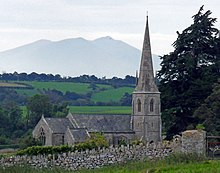| St Edwen's Church, Llanedwen | |
|---|---|
 The north side of St Edwen's | |
Location in Anglesey | |
| 53°11′26″N 4°13′12″W / 53.190578°N 4.220076°W | |
| OS grid reference | SH 517 682 |
| Location | Llanedwen, Anglesey |
| Country | Wales, United Kingdom |
| Denomination | Church in Wales |
| Website | Parish website |
| History | |
| Status | Parish church |
| Founded | 640; current building 1856 |
| Founder(s) | St Edwen |
| Dedication | St Edwen |
| Architecture | |
| Functional status | Active |
| Heritage designation | Grade II |
| Designated | 23 April 1998 |
| Architect(s) | Henry Kennedy |
| Architectural type | Church |
| Style | Late Decorated |
| Specifications | |
| Materials | Rubble masonry with red gritstone |
| Administration | |
| Province | Province of Wales |
| Diocese | Diocese of Bangor |
| Archdeaconry | Bangor |
| Deanery | Synod Ynys Mon |
| Parish | Bro Dwynwen |
| Clergy | |
| Priest in charge | Reverend E Roberts |
| Assistant priest(s) | Canon Professor Leslie Francis |
St Edwen's Church, Llanedwen, is a 19th-century parish church near the Menai Strait, in Anglesey, north Wales. The first church was founded here by St. Edwen (daughter of Edwin of Northumbria, king and saint) in 640, but the present structure dates from 1856 and was designed by Henry Kennedy, the architect of the Diocese of Bangor. It contains some memorials from the 17th and 18th centuries and a reading desk that reuses panel work from the 14th and 17th centuries. The 18th-century historian Henry Rowlands was vicar here, and is buried in the churchyard. The church is on land that forms part of the Plas Newydd estate, home of the family of the Marquess of Anglesey since 1812 and owned by the National Trust. Some of the Marquesses of Anglesey, and some of their employees, are also buried in the churchyard.
The church is used for worship by the Church in Wales, one of seven in a combined parish. A service is held using the Book of Common Prayer each Sunday morning. St Edwen's is one of the few churches in regular use in Wales to be lit entirely by candles. It is a Grade II listed building, a national designation given to "buildings of special interest, which warrant every effort being made to preserve them",[1] in particular because it is regarded as "a good example of H Kennedy's designs for a small-scale rural church."[2]
- ^ What is listing? (PDF). Cadw. 2005. p. 6. ISBN 1-85760-222-6.
- ^ Cadw. "Church of St. Edwen (Grade II) (19743)". National Historic Assets of Wales. Retrieved 2 April 2019.
